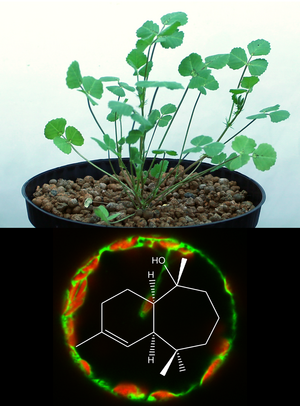Early communication between plant roots and soil-borne microorganisms

Fig. 1:
Inoculation of Medicago truncatula roots with Aphanomyces euteiches spores leads to rapid upregulation of MtTPS10 encoding a sesquiterpene symthase. MtTPS10 is located in the cytosol and produces a blend of sesquiterpenes. The upper part of the picture shows an M. truncatula plant, the lower part a Nicotiana benthamiana protoplast expressing a TPS10-mCherry fusion (green fluorescence within the cytolsol) and the formula of himachalol, the main product of MtTPS10.
Plant roots interact with a variety of microorganisms. Metabolites that are released as root exudates or volatiles contribute to selecting the beneficial and repelling the detrimental microorgansims. To get insights into this response of plants to various microorganisms, we used Medicago truncatula as it is a natural host for root pathogens, such as the oomycete Aphanomyces euteiches, but also for mutualistic symbionts, such as the arbuscular mycorrhizal fungus Rhizophagus irregularis. Several volatiles were found to be emitted specifically in response to each of the microorganisms (Dreher et al., 2019). A transcript profiling approach revealed the specific up-regulation of several genes in pathogen-infected roots, among them a gene encoding the sesquiterpene synthase MtTPS10 (Fig. 1, Yadav et al., 2019). Roots defective in MtTPS10 function failed to produce some volatile sesquiterpenes after infection and showed higher susceptibility to the pathogen pointing to a function of TPS10 products in the defense of M. truncatula against oomycetes. Questions, such as how TPS10 is induced by pathogens and are there modifications of its products in planta, but also the characterization of other differentially regulated genes are in focus of current and future work.
Dreher, D., Baldermann, S., Schreiner, M., and Hause, B. (2019). An arbuscular mycorrhizal fungus and a root pathogen induce different volatiles emitted by Medicago truncatula roots. J. Adv. Res. 19, 85-90.
Yadav, H., Dreher, D., Athmer, B., Porzel, A., Gavrin, A., Baldermann, S., Tissier, A., and Hause, B. (2019). Medicago TERPENE SYNTHASE 10 is involved in defense against an oomycete root pathogen. Plant Physiol. 180, 1598-1613
This page was last modified on 27 Jan 2025 05 Feb 2025 .

